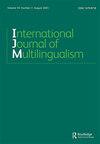Linguistic landscape in a rural Basque area: a case study in Ondarroa
IF 2
1区 文学
Q2 EDUCATION & EDUCATIONAL RESEARCH
引用次数: 0
Abstract
Basque is one of the official languages spoken in the Basque Country and although it is usually considered the minoritised language, its situation might be different in rural areas. The presence of Basque and Spanish has been previously reported in urban areas [Cenoz, J., & Gorter, D. (2006). Linguistic landscape and minority languages. International Journal of Multilingualism, 3(1), 67–80. https://doi.org/10.1080/14790710608668386], but their presence in rural areas remains unknown. To address this gap, the linguistic landscape (LL) of a rural town (Ondarroa, Bizkaia) is examined. For such a purpose, the signs in the main shopping street of Ondarroa (both top-down and bottom-up signs) are included in the analysis. The results show that contrary to the situation of Basque in urban areas (Cenoz & Gorter, 2006), Basque is the language with the largest presence in the LL of the street in Ondarroa. This is an indicative of the reproduction of the linguistic situation of the town, which subverts the current institutional linguistic policies. This particular LL could be considered as highly bilingual due to the presence of bilingual signs in Basque and Spanish; the presence of Spanish monolingual signs is minimal. The analysis of this LL would indicate that Basque sometimes is the majority language, at least in rural Basque areas.巴斯克乡村地区的语言景观:昂达罗亚的个案研究
巴斯克语是巴斯克地区的官方语言之一,虽然它通常被认为是少数民族语言,但它在农村地区的情况可能不同。以前在城市地区也有巴斯克语和西班牙语的报道[Cenoz, J., & Gorter, D.(2006)]。语言景观与少数民族语言。国际语言学报,3(1),67-80。https://doi.org/10.1080/14790710608668386],但它们在农村地区的存在仍然未知。为了解决这一差距,研究了一个乡村小镇(比斯卡亚翁达罗)的语言景观(LL)。为此,Ondarroa主要购物街的标志(包括自上而下和自下而上的标志)被纳入分析。结果表明,与巴斯克语在城市地区的情况相反(Cenoz & Gorter, 2006),巴斯克语是在Ondarroa街道的LL中存在最多的语言。这是对城镇语言情境的再现,颠覆了现行的制度性语言政策。由于巴斯克语和西班牙语的双语标志的存在,这个特殊的LL可以被认为是高度双语的;西班牙语单语标志的出现很少。对这一语言的分析表明,巴斯克语有时是多数语言,至少在巴斯克农村地区。
本文章由计算机程序翻译,如有差异,请以英文原文为准。
求助全文
约1分钟内获得全文
求助全文
来源期刊

International Journal of Multilingualism
Multiple-
CiteScore
6.10
自引率
8.70%
发文量
67
期刊介绍:
The aim of the International Journal of Multilingualism (IJM) is to foster, present and spread research focused on psycholinguistic, sociolinguistic and educational aspects of multilingual acquisition and multilingualism. The journal is interdisciplinary and seeks to go beyond bilingualism and second language acquisition by developing the understanding of the specific characteristics of acquiring, processing and using more than two languages. The International Journal of Multilingualism (IJM) provides a forum wherein academics, researchers and practitioners may read and publish high-quality, original and state-of-the-art papers describing theoretical and empirical aspects that can contribute to advance our understanding of multilingualism.Topics of interest to IJM include, but are not limited to the following: early trilingualism, multilingual competence, foreign language learning within bilingual education, multilingual literacy, multilingual identity, metalinguistic awareness in multilinguals, multilingual representations in the mind or language use in multilingual communities. The editors encourage the submission of high quality papers on these areas as well as on other topics relevant to the interest of the International Journal Multilingualism (IJM). Reviews of important, up-to-date, relevant publications and proposals for special issues on relevant topics are also welcome.
 求助内容:
求助内容: 应助结果提醒方式:
应助结果提醒方式:


